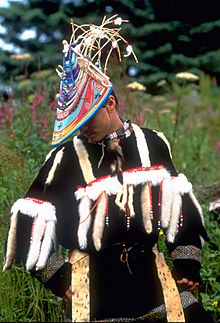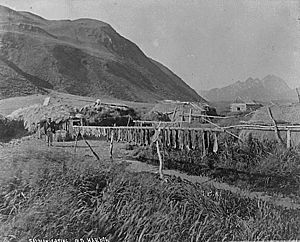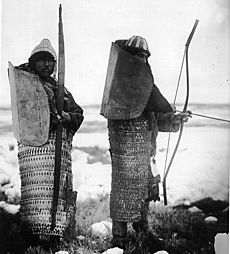Alutiiq facts for kids

A Sugpiaq dancer
|
|
| Total population | |
|---|---|
| 4.000-12.000 | |
| Regions with significant populations | |
| Languages | |
| Sugcestun, English, Russian | |
| Religion | |
| Russian Orthodox Church, traditional religion | |
| Related ethnic groups | |
| Yup'ik, Aleut |
The Alutiiq people (pronounced /əˈluːtɪk/ in English; from Promyshlenniki Russian Алеутъ, "Aleut"; plural often "Alutiit"), also called by their ancestral name Sugpiaq (/ˈsʊɡˌbjɑːk/ or /ˈsʊɡpiˌæk/; plural often "Sugpiat"), as well as Pacific Eskimo or Pacific Yupik, are a southern coastal people of Alaska Natives.
Their traditional homelands include Prince William Sound and outer Kenai Peninsula (Chugach Sugpiaq), the Kodiak Archipelago and the Alaska Peninsula (Koniag Alutiiq). In the early 1800s there were more than 60 Alutiiq villages in the Kodiak archipelago, with an estimated population of 13,000 people. Today more than 4,000 Alutiiq people live in Alaska.
Terminology
At present, the most commonly used title is Alutiiq (singular), Alutiik (dual), Alutiit (plural). These terms derive from the names (Алеутъ, Aleut) that Russian fur traders and settlers gave to the native people in the region. Russian occupation began in 1784, following their massacre of hundreds of Sugpiat at Refuge Rock (Awa'uq) just off the coast of Sitkalidak Island near the present-day village of Old Harbor (Nuniaq).
Given the violence underlying the colonial period, and confusion because the Sugpiaq term for Aleut is Alutiiq, some Alaska Natives from the region have advocated use of the terms that the people themselves use to describe their people and language: Sugpiaq (singular), Sugpiak (dual), Sugpiat (plural) — to identify the people (meaning "the real people"), and Sugstun, Sugcestun, Sugt'stun, or Sugtestun to refer to the language. All three names (Alutiiq, Aleut, and Sugpiaq) are used now, according to personal preference. Over time, many other ethnonyms were used to refer to this people.
Culture
Fishing and housing
The people traditionally lived a coastal lifestyle, subsisting primarily on ocean resources such as salmon, halibut, and whale. They supplemented these maritime foods with rich land resources, such as berries and land mammals. Before contact with Russian fur traders, they lived in semi-subterranean homes called ciqlluaq. Today, in the 21st century, the Alutiiq live in coastal fishing communities in more modern housing. They work in all aspects of the modern economy, while also maintaining the cultural value of subsistence.
Language
In 2010 the high school in Kodiak responded to requests from Alutiiq students and agreed to teach the Alutiiq language. It is one of the Eskimo–Aleut languages, belonging to the Yup'ik branch of these languages. The Kodiak dialect of the language was being spoken by only about 50 persons, all of them elderly, and the dialect was in danger of being lost entirely.
Notable Alutiit
- Alvin Eli Amason, painter and sculptor
- Linda Infante Lyons, painter and muralist
- Cungagnaq, also known as Peter the Aleut, an Eastern Orthodox saint, reportedly from Kodiak Island.
- Loren Leman, Lieutenant-governor of Alaska, 2002-2006
- Sven Haakanson, executive director of the Alutiiq Museum, and winner of a 2007 MacArthur Fellowship.
See also
 In Spanish: Alutiiq para niños
In Spanish: Alutiiq para niños




